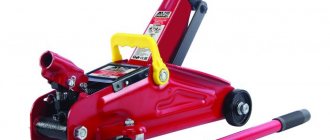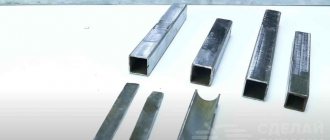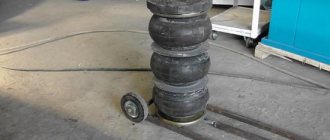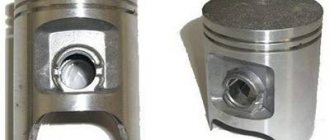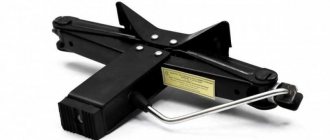The question of what kind of oil is poured into hydraulic jacks is not asked by many car enthusiasts, despite the popularity of the devices not only among service center workers, but also among ordinary car owners.
The design seems simple, reliable, unpretentious in everyday life, and you simply don’t want to pay extra attention to it. But in reality, lubricating fluid is the main design element, on which safety and ease of use directly depend.
Oil for hydraulic jacks
Hydraulic jacks have become quite widespread. They can be used to lift various heavy loads. The operating principle of the design determines that the required pressure is created by supplying special oil to the working chamber. Periodic maintenance includes changing the oil in the hydraulic jack, as over time it can lose its properties. That is why you need to pay attention to what characteristics oil for hydraulic jacks should have.
Main causes of breakdowns
A rolling jack, which can be repaired at home, can have several causes of breakdowns. The most common of them are: complete or partial failure of the device to lift heavy loads, as well as oil leakage. Each of these problems requires immediate repair.
The rolling jack (repair, oil change, characteristics are described in detail in this article) very often fails as a result of oil leakage. In this case, you will have to completely disassemble the device. Be sure to remove the pistons and check for corrosion. Thoroughly clean all structural elements and remove all kinds of dirt. Now check the stem. If you find that it is warped and damaged, you may not even try to repair it yourself. In this case, you will most likely have to purchase a new jack.
Another common reason for device failure is clogging or breakdown of special valves, which, in fact, are responsible for lowering and raising the mechanism.
Hydraulic oil requirements
Almost all oils for lifting structures are made from base hydraulic fluids, which are obtained by processing petroleum fractions. Oil for hydraulic rolling jacks is characterized by the presence of various additives, which significantly improve performance characteristics. Among other features, we note the following points:
Rolling hydraulic jack
Some of the above characteristics are indicated by the manufacturer on the packaging.
Tips for choosing oil
A fairly common question is what kind of oil is poured into a hydraulic jack. There are several varieties on sale:
Synthetic fluids are most widespread. They are characterized by increased safety, since production involves a complex technological process. Glycol versions are also common, the chemical composition of which determines high performance characteristics. In terms of price and quality, glycols outperform almost all others.
The cheapest option is petroleum or mineral oils. However, before pouring them into a rolling jack, it is worth taking into account the relatively low performance characteristics.
Synthetic hydraulic oil
In some cases, used engine oil is refilled. It is necessary to use special oil, as it ensures long-term operation of the device. The lubricant should be changed at the moment when the device begins to work incorrectly.
Some useful tips
In order for the hydraulic rolling jack to work correctly, it is imperative to use only hydraulic oil. This is due to the fact that only it can provide the necessary viscosity. Plain motor oil has a lower viscosity. Even without air getting in, it doesn’t work quite right.
In production, when it comes to important equipment, people always use only specialized hydraulic oil
There is a special oil for hydraulic jacks.
It allows any units to operate for many years without any breakdowns. It is quite easy to purchase it today. It is distributed by specialized stores. Of course, it is best to first find out which oil is best suited for a given model of hydraulic jack.
Most often, such information is indicated on the packaging. Based on it, we can already draw some definite conclusions. Yes, there are models of ordinary oil that have similar properties to hydraulic oil, but it is not always suitable in this particular situation. You should definitely follow the manufacturer’s advice and recommendations.
When purchasing a hydraulic rolling jack, you can always check its compression properties, so as not to end up with a faulty device that will immediately have to be pumped. It is immediately worth determining its compliance with the original indicators and characteristics. Only then will it be necessary to carry out repairs much less frequently than in the case of a unit that does not meet the performance indicators in advance. Sometimes the indicators on the packaging do not correspond to what is actually indicated by the manufacturer. Checking is never superfluous. This is the only way to get a truly high-quality device at your disposal.
Scheme for bleeding a hydraulic rolling jack.
When pumping, be sure to follow the instructions presented above. This is the only way to achieve a truly good result. If you want to use other methods, you can always find them on the websites. There really are no better options. The hydraulic rolling jack has become a real assistant for all car mechanics and tire fitters. He always comes to the aid of his owners. This work of modern technology should not be ignored if today it is widely available to everyone.
So, now we can summarize some of what was said above. Now everyone knows how to bleed a hydraulic rolling jack. There is nothing complicated about this process. If you strictly follow the instructions, you can always get the desired result in practice. Hydraulics has always been considered a fancy thing. It is influenced by many different characteristics.
How to change the oil in a jack
A sign that the oil in the hydraulic jack needs to be changed is the slow rise and fall of the device. It is worth considering that liquid may leak if the device is transported incorrectly. In a horizontal position in a hydraulic device, liquid flows to the valves, after which it begins to flow out. The place of the working fluid is taken by air, which significantly reduces the efficiency of the structure.
When considering how to fill a bottle jack, you need to pay attention to the following points:
Pouring oil into the jack
It is worth considering that when draining the oil, there is a possibility of losing the metal ball that acts as a valve. That is why the procedure in question must be carried out carefully.
In addition to special substances, industrial types can also be used, for example, I12A or I40A. It is worth considering that many of them are characterized by increased viscosity. That is why, before using industrial oils, you need to check whether they are suitable for a specific model of hydraulic jack.
In some cases, brake fluid is used. It is worth considering that it is only partially suitable as a working medium for lifting mechanisms. This is due to the high hygroscopicity rate. Some time after applying the brake fluid, the water contained in the composition leads to the beginning of the corrosion process. That is why experts do not recommend using such a liquid to operate a hydraulic jack.
The above information indicates that no special equipment is required to change the oil. The level is filled to the mark indicated by the manufacturer on the body. Levels that are too high or low will cause the lifting mechanism to not operate correctly.
In conclusion, we note that only by using special oil can a long service life of the device be ensured. A conventional substance or waste is much cheaper, but does not provide the required operating conditions.
Source
Reasons for decreased efficiency
Due to its characteristics, the rolling jack is designed to work with liquids, which provide high lifting capacity.
Most often we are talking about oil. A special hydraulic version of this fluid is used here. In order for the jack to serve for a long time, it is necessary to monitor the presence of oil in it and the condition of the oil seal and valves.
Basically, this design is considered one of the most reliable. It is capable of working with a wide variety of weights. Sometimes the lifting capacity of such a jack can reach several tens of tons. The efficiency is the highest among all representatives of the class of similar equipment.
However, no one is immune from the fact that the rolling hydraulic jack fails. There may be several reasons for this. The main reason is often the accumulation of a large number of air bubbles in the work area. This is fatal for any hydraulic device. Very often this leads to the need to pump the hydraulics. Air bubbles can dramatically reduce the efficiency of a device of this type.
It is imperative to regularly check the amount of oil in the hydraulic jack system. If its level decreases, this has a detrimental effect on the entire operation of the device. The free space is quickly filled with air bubbles. At the same time, work deteriorates sharply. This directly affects the load capacity. There are many methods that allow you to troubleshoot this type of problem. All of them have a right to exist. Below we will look at several options for how to do this. So, you can proceed directly to the instructions.
Oils recommended for use in hydraulic jacks
The standard fluid for filling into the mechanism is spindle oil I20A. This product is universal and can be used at any time of the year. The situation is somewhat different with industrial lubricants VMGZ, I12A, I30A, I40A or I50A. These compositions will be quite effective only in the warm season, but only for specific device models.
Such options are the most common due to their practicality and low cost. If possible, it is worth purchasing specific compounds, especially for hydraulics. The liquid has a low level of viscosity, and they also combine properties and capabilities that meet all requirements.
Working principle of a hydraulic jack
The design uses the principle of communicating vessels. Force is applied to the drive handle (using an electric motor or manually). By means of a lever, force is supplied to the injection pump. Oil enters the bottom of the cylinder tank when the lever is pressed or the electric motor is started. The piston rises. The bypass valve, which consists of the discharge and suction valves, keeps the oil pressure at a constant operating level. The suction valve is located at the inlet of the container and does not allow oil to return when the piston is lowered. The injection pump is installed at the inlet of the cylinder and does not let oil out while the piston is rising.
To reduce the pressure and lower the load, open the valve with a special screw.
What is the difference between hydraulic jacks that puts them in first place among other types of lifting equipment:
Read also: What kind of electricity meters are installed in the apartment
The hydraulic mechanism can handle objects placed very low, lifting them off the floor. This is a big advantage compared to other types of lifting devices.
In the event of a breakdown, repairs are more complex and expensive than with a mechanical analogue. The hydraulic lifting device works with loads weighing 2 - 200 tons.
Special-purpose devices are capable of lifting very bulky loads to great heights, fixing them and holding them.
The single-rod hydraulic bottle jack is very easy to use, which is why its variations are most widely used.
The dolly has a low landing and is mounted on wheels. Levers extend from the body to lift the load. Typically, such equipment will have a drive handle of sufficient size to reduce the force applied. A mechanism of this type can only work on a hard and smooth base.
Long-term operation of the jack is possible only if the rules of use are strictly followed. One of the prerequisites is timely refilling of oil, control over its level and purity.
The range of applications of a jack is much wider than just using it when changing tires on a car. Any experienced car owner knows when to use this device. But in addition to operating rules, it is important to know how to properly maintain and replace hydraulic material.
Unlike existing lifting mechanisms, the jack has small dimensions and weight, simple operation, convenience and a high degree of reliability. For every car owner, such a tool is a necessary and very important thing.
There are several main types of jacks:
The control can be manual or electric. Some models can handle loads of up to several hundred tons.
Characteristics of types of jacks
Lifts come in various types, each of which has its own distinctive features and characteristics:
- Mechanical jack is the most famous equipment, characterized by light weight, fast working stroke, high lifting level and low cost. Its disadvantages include low stability, since mechanical equipment has a small support area.
- An electric lift is equipment that is controlled by a special small unit and operates from the electrical wiring of the machine. Such a jack can lift up to two tons of weight. Among the disadvantages are its large mass and manual lowering, which requires a lot of time.
- A pneumatic jack is powered by a compressor or compressed air, is lightweight and has a large support area.
- Hydraulic equipment is the most popular and is used both in car repairs and during construction work to lift various heavy structures. The lifting capacity of hydraulic jacks is up to 200 tons, and the efficiency reaches 80%. However, this lift also has a drawback - it cannot be transported in a lying position, since the equipment mechanism may fail.
For high-quality operation of the equipment, it is necessary to use special oils. Such compositions are divided into several groups and have their own purpose.
Main types of oils:
- flushing;
- transmission;
- motor;
- hydraulic.
Hydraulic compounds are used to service jacks, the selection of which requires care and responsibility.
What should the oil be like?
When filling the jack, we use hydraulic oils. The basis for the product is the base oil obtained during oil refining. An additive is added to this base oil to ensure the required technical characteristics and the absence of foam formation. In general, there are three types of hydraulic oils: petroleum, synthetic and glycol. A good oil for filling a jack must meet the following requirements:
Read also: Design of a centrifugal water pump
Qualitative characteristics of the liquid
The most important indicator of high quality hydraulic oil is its viscosity. It determines how easily the parts of the device will move. That is why, when choosing a liquid, they strive to use the optimal viscosity value. The properties of the liquid are influenced by the temperature index (viscosity index). It should have high values .
Hydraulic oil never oxidizes. It has excellent anti-corrosion characteristics, which increase the service life of the jack.
Main requirements for hydraulic oil
Hydraulic compounds for lifts are divided into three main groups: glycol; synthetic; petroleum _
Also, such oils are popular for servicing aircraft, ships, marine equipment, engines, and shock absorbers.
Almost all types of hydraulic fluids are made from base oils, which are produced by processing petroleum fractions. Then the base base is cleaned and special additives are added . Due to such additives, hydraulic oil does not foam and provides the mechanism with protection from oxidation and corrosion.
When choosing oil for a jack, you need to pay attention to some indicators:
Read also: Threading machines
A correctly selected hydraulic oil will not be affected by the chemical composition of the environment and high temperature fluctuations. The liquid will not undergo oxidation and will protect the mechanism from premature wear.
Features of using hydraulic oil
In the warm season, the mechanisms can be filled with any type of oil, but in winter it is recommended to choose a synthetic composition. This is due to the fact that the synthetic liquid will not freeze even in severe frost, which means that the equipment can be safely used.
Hydraulic oil should be changed at least twice a year. If the equipment is used systematically, then it should be washed , while replacing the old hydraulic composition with a new one. In this case, the jack will work for many years without any repairs.
Main stages of disassembly and repair
It has a large number of fasteners; it must be disassembled in the following order. You don't need any special tools to disassemble the mechanism and reassemble it. First, use wrenches to unscrew all the fasteners, then remove the oil drain valve and the piston itself. Carefully inspect the valve and check its condition. If the ball and gaskets are worn out, they must be replaced with new parts.
Drain the oil, clean the mechanism from foreign objects and rust, and flush the system. Washing is done using a special liquid, which is sold in hardware stores. It needs to be done several times in a row, since this process is quite complex. After flushing, you will need to add new oil, otherwise the hydraulics will not work.
When filling, the container is filled to the brim with new oil, after which it is pumped and new oil is added. You need to pump several times until the oil is filled in in sufficient volume and bubbles stop appearing. After this, the condition of all rubber bands is checked and, if necessary, they are replaced with new ones. Reassembling the unit is done in the reverse order. After assembly, do not forget to check its functionality.
When changing the oil, the device should not experience any stress, so you can carry out the work easier and faster. It is necessary to disassemble, inspect, replace oil and worn parts several times a year. It is better to use the tool in a dry and warm place; for the winter season, use synthetic oils.
So, if necessary, disassemble the jack yourself, there is nothing complicated about it. You can identify most of the breakdowns yourself and fix them. Mostly, malfunctions occur due to the need to change the oil or a clogged system. If you regularly monitor the condition of the tool, you can avoid many breakdowns. To extend its service life, it is recommended to use special high-quality oil, which is used for industrial equipment.
The jack does not work. I was lying in my garage, but then I urgently needed to lift it... and it doesn’t work for you! What can you do with it, and quickly? 1. Let's test it idle: with the locking screw unscrewed, 10 swings, turn it all the way (without fanaticism), swing. Options: - raises to 1/3 of the height and stands up. That is, there is not enough oil. We unscrew (or pull the rubber with pliers) the filler plug, measure the level - level with the hole, for others it is even higher. We are looking for something to add - the brake fluid is not allowed, the transmission is acceptable, A motorboat is possible, but an industrial one is necessary. We are testing it. — it raises very slowly when the handle is lowered, and when it is raised, it lowers. We look at the oil. We unscrew the plugs and the discharge plunger housing and look for a foreign body — a piece of rubber/plastic, do not lose the spring-balls, water has leaked out — go to the service center. - does not lift. We look at the oil - look for a blockage - take it to the service center. - oil leaks out. We stretch it - clean it in search of a jack model (if SHAAZ 8t / SHAAZ 12t you have no chance) - to the shops (repair kit) - they politely send it ** - to the service. -raises very slowly, holds. Raise by 1/4 stroke, release the filler plug, tighten securely (thumb - tape to help). Or dilute with 10% kerosene. 2. We test under load: - the load does not hold. We unscrew the locking pin. There is no ball - we install it from a bearing Ф 6 mm. There is no ball, but there is a cone on the screw (what an old piece you have!) - take it to a turner to grind it and straighten the seat. For those who have not identified their hydraulic jack, a photo to help:
SHAAZ 5t. telescopic.
SHAAZ 3t telescope.
3 Comments 3
No matter how rich a specialist’s experience is, and no matter how confident he is, sometimes he needs to consult with someone. Communication on the Internet has long become familiar to us. Various network users - whether a professional or a knowledgeable amateur - can post life hacks (simple useful tips on various topics) online that can be usefully applied to your home.
What are the advantages of using forum resources?
- A constant flow of interesting information about new building ideas.
- Simple and useful tips for construction.
- The opportunity to communicate with interesting people, experienced professionals in their field.
- Recommendations for choosing tools or materials.
- Also a pleasant plus is the lack of advertising, because users are consumers just like you.
The process of changing the oil in the jack
First of all, we unscrew the filler plug, after which we drain the liquid. The inside of the mechanism is carefully and several times treated with a special washing liquid. After this, using a funnel, oil is poured inside to the maximum mark. Having filled the composition, we tighten the plug, after which we pump the unit. This must be done several times (usually at least six), since with each pumping the oil will be compressed and its pressure should be brought to the required values. This signifies the appearance of bubbles, which indicates the maximum oil level in the unit.
Important! The process of adding oil to the jack may vary depending on the model. So it is extremely important to find a guide specifically for your model so as not to run into pitfalls.
At the same time, you can give a few more tips on refueling the unit:
Source
Instructions
Initially, it is worth deciding what exactly is meant by “pumping” in relation to modern lifting mechanisms. We are talking about a set of actions aimed at displacing air from hydraulic cylinders. In this case, the whole process comes down to pumping the working fluid with a pump. This was precisely the determining factor in the appearance of the name of the procedure, which is one of the most important points in the maintenance of lifting devices.
Those who have at their disposal an old hydraulic jack or a relatively new model of modern lifting equipment with obvious signs of airiness need to know how to quickly deal with such a problem. Nowadays you can find a large amount of relevant information on the Internet. First of all, it should be noted that to effectively restore the functionality of the device, you will need a standard arsenal of tools, as well as about 300 ml of ordinary mineral oil or special fluid for hydraulic systems.
To effectively bleed a bottle-type hydraulic jack, you will need to perform the following steps.
- First of all, you have to find the filler hole, which is sealed as tightly as possible with a rubber stopper. In the vast majority of cases, it is located at the top of the device. Taking into account the design features of different models, the plug can be recessed into the body or protruding above it.
- Open the oil fill hole, carefully removing the plug to avoid damaging it.
- Completely drain all working fluid. It is worth considering that this measure is relevant in cases where it is necessary to service an old hydraulic jack that has been actively used for a long time without maintenance. To completely remove any remaining oil, unscrew the bypass valve and lower the piston all the way.
- Rinse the cylinders using special liquids, as well as kerosene or oil, which will be filled afterwards. To do this, you need to pour the flushing agent through the previously mentioned hole, pump the piston to the top point, and then open the valve and lower the rod all the way. This procedure must be repeated several times.
- Fill the hydraulic cylinder with oil by placing the bottle hydraulic jack in its working, that is, vertical position. Experienced users and specialists advise using a syringe.
- After the container is filled to the maximum level, screw the bypass valve all the way. At the next stage, use up/down movements to raise the piston of the device until it stops.
- Then you need to unscrew the valve a little and manually lower the piston with the filler hole open. This sequence of actions is repeated several times.
- If the described algorithm does not lead to the desired results, and air remains in the system, then you can unscrew the shut-off valve several turns, lift the piston manually and sharply lower it. In this case, the use of a pump is excluded. Such manipulations are repeated several times, and with each approach the length to which the rod extends is reduced by 1 cm. As a rule, such radical measures allow you to quickly get rid of air in the hydraulic system.
Hydraulic lifts of the rolling type are characterized, first of all, by increased load capacity. In this case, the main performance indicator directly depends on the tightness of the system and the pressure created in the working chambers. To maintain full functionality of rolling models, they need to be periodically pumped.
The source of problems with this category of hydraulic jacks can be contamination and air ingress. There are several ways to correct the situation. The first option for pumping rolling equipment involves the following steps:
- open the oil filler plug;
- unscrew the bypass valve;
- Bleed the working cylinder with quick movements;
- Screw the valve all the way and close the filler hole tightly.
Unfortunately, in some situations, the manipulations described above cannot completely squeeze out the air from the hydraulic system. At the same time, many are interested in how to identify its remains in the jack cylinders.
In such cases, you will need to find a locking needle, which is an integral part of the design of any modern rolling hydraulic jack. It is turned out 2-3 turns, after which, in manual mode, the piston should be extended several times until it stops and returned to its original position. As a result of such manipulations, as in the situation with bottle models of equipment, the air will be completely squeezed out of the system.
How to fill a hydraulic jack with oil?
Content
What comes to your mind when you think of a hydraulic jack? If lifting weights is easy and there is no strain on your back, then you are an optimist. If maintenance and oil changes are complex, then a pessimist. But let's not divide everything into black and white. And let's not focus only on the shortcomings. Moreover, we will tell you how to easily and without problems fill a hydraulic jack with oil.
Is it really time to change the oil?
Everyone knows how to use a jack. But how and with what regularity to service it is a mystery to many. To understand why and how often to refill equipment with oil, let’s figure out how it works.
What is the structure of a hydraulic jack?
It is based on the principle of operation of communicating vessels. You press the handle, the fluid from the injection pump is pushed into the cylinder, the piston begins to move, lifting the load. Compared to a mechanical jack, a hydraulic one requires less physical effort and time. Working with him is easier and faster. But this jack design also has its drawbacks. Often, liquid leaks from the housing, for example, due to improper storage or simply over time.
How often should you change the oil in your jack?
If used infrequently, the oil in the jack should be changed 2 times a year . But if you work with this equipment regularly, then it is better to replace it every month .
Why do you need to change the oil?
If the oil has leaked out or lost its original properties, the jack may, firstly, stop working - the piston simply will not rise, and secondly, break - the mechanisms inside may rust, excess air may accumulate in the structure, etc. Even the best jack, without proper maintenance, can suddenly drop a load at the wrong time. Because of this, the car, for example, can fall directly onto the underbody. At such moments, even a car mechanic can suffer. Timely change of oil in the jack is a guarantee of the safety of the cargo and your safety.
How often to change the fluid
Having studied all the possible options, and having analyzed in detail what to pour into the hydraulic jack, it remains to clarify the frequency of performing this procedure. It is worth noting that there is no exact fluid change interval, and these periods depend on the intensity of use of the jack, storage conditions, operation, as well as the initial purity of the oil. It is better to change the mixture 2-3 times more often, unlike pure mixtures.
Still, you need to set at least an approximate time, based on certain situations. If you use a jack for seasonal tire service on one car, doing it carefully and in a clean garage, you can not change the fluid for more than 2 years. For more intensive use, from 2 to 4 cars, it is worth devoting time to this once a year. When working in a car repair shop, where the jack is constantly in use, the oil should be changed once a month, or even more often (depending on the cleanliness of the room). When using a lift in construction, where it is constantly in contact with dust and dirt, the oil change procedure should be carried out once every 1-2 months (depending on how often it is used).
To reduce the intervals between maintenance procedures. maintenance, and maintain the pristine purity of the oil, you should adhere to simple operating rules. Before lowering the stop, wipe the piston with a rag and try not to operate the pump in dusty areas. Treat your instrument with care and it will serve you faithfully for many years.
Save this page on your social media. network and return to it at any time.
What kind of oil should I put in the jack?
Attention!
Do not fill the equipment with engine oil, brake or transmission fluid, glycerin, or water. These fluids can cause mechanical damage, corrosion, and cause the jack to suddenly fall when loaded.
What do you put in the jack? Only hydraulic oil can ensure long, productive and safe operation.
Before filling the jack, you need to decide which oil is more suitable. This choice will determine how well the equipment will perform and how long it will last you. A suitable fluid can be easily selected in the “Hydraulic Oils” section on our website. To do this, simply enter the name of your jack or product code on our website in the search bar.
The site will direct you to the “Consumables” section in the product card, where you will need to select the required item.
You can also simply go to this section from the product card.
A high-quality hydraulic jack oil should have the following properties.
This is a designation for the fluidity of the oil. It is selected depending on climatic conditions. The colder the operating conditions, the lower the value should be. Viscosity grade is usually abbreviated VG (Viscosity Grade) and has values ranging from 5 to 150.
Low viscosity: 5 – 15
Average viscosity: 22 – 32
High viscosity: 46 – 150
In Russian conditions, it is better to choose a value slightly above average. Oils with low viscosity will not lubricate parts well, while oils with high viscosity will freeze very hard in the cold. , oils with viscosity class 32 are most often used . Let's give examples from the site VseInstrumenty.ru.
On our website it is easy to choose an oil with a suitable viscosity class. Just select the desired filter.
Oils often indicate at what temperatures they can be used. This makes the choice much easier. To choose the right oil for the temperature range, decide where you will use the jack: in a warm garage, a car service center or on a winter road.
For example, for working outside in cold weather, oils with a low minimum operating temperature are suitable.
To work in hot workshops or outdoors under the scorching sun, it is better to use oils with a high maximum operating temperature.
Almost any oil is suitable for working in a warm garage or car service center
On our website in the filters you can set the required minimum and maximum temperature for oil use.
Additives are often added to oils to protect mechanisms from rust. This is useful if the jack is used in highly dirty or humid conditions. If the oil protects parts from corrosion, the equipment will serve you for a long time. The presence of anti-corrosion properties is usually written on the label or in the product card.
During operation, bubbles form in many oils, which subsequently lead to the accumulation of excess air in the pump. They can lead to poor performance or damage to the jack. To prevent this, special additives are added to oils to prevent the formation of bubbles. Information about the presence of anti-foam properties is usually indicated on the label.
How to fill oil into a jack?
To ensure cleanliness in the workplace, it is better to immediately lay down napkins, newspapers, paper or polyethylene. Don't forget to place a container into which you will drain the old oil.
Step 1: Lower the jack
This is necessary so that all the liquid ends up in the oil reservoir. How to lower the jack? Simply turn the bypass valve, which is located at the bottom of the housing, and the working piston will move down. In this position it is more convenient to carry out servicing of the jack.
Step 2: Find the oil fill hole
There are different types of jacks, and their holes are located in different places. In a bottle bottle it is located on the tank (large cylinder). In a rolling jack, the hole is also usually located in the main cylinder. You may have to unscrew the cap above the reservoir. The hole can be closed either with a screw or a plug.
Step 3: Drain the old oil
Remove the plug or screw from the oil fill hole. For convenience, the reservoir of the rolling jack can be removed. If the equipment is not dismountable, you can simply turn the jack over. To speed up the draining, you can pump the pump several times. Some oil may remain under the piston. It also needs to be moved up and down several times.
Step 4: Fill with new oil
Using a syringe or oil can, pour the working fluid into the hole located on the tank. Tighten the screw or cover it with a plug.
Step 5: Get rid of excess air in the jack
To do this, lower and raise the jack handle several times. This will help flush out all the excess air.
Filling the jack with oil is not at all difficult. To do this, it is not necessary to contact the service center. We are confident that you will do great on your own! We hope that our tips will be useful to you.
Source
Refueling mechanisms
Next, we’ll look at how to properly fill the recommended oil into a jack. Sometimes, if transported incorrectly, hydraulic fluid can spill out and the voids can be filled with air. This will cause the jack to fail. In this case, an oil change is necessary.
The rack and pinion mechanism is quite large; it is used not only for lifting the body, but also for repairing old buildings. Before changing the lubricant, the mechanism must be completely lowered. To verify this, you can relieve residual stress by turning the exhaust valve counterclockwise.
The neck into which the filling is made is usually located on the tank body, usually in the lower part of the cylinder. It is necessary to free the neck from the bolt or plug that reliably protects the oil in the container. Then you will need an oil can, the nozzle of which must be inserted into the neck and filled.
There is enough hydraulic fluid when it starts to overflow. Now all that remains is to firmly tighten the bolt or insert the plug.
Pouring lubricant into a bottle jack will have to be a little different. But first you also need to make sure that the mechanism is lowered all the way. You can secure yourself using the same method as in a rack and pinion mechanism.
In a bottle design, the plug should be found on the top of the master cylinder body. First, remove the plug and fill it using an oil can, which is first filled with hydraulic oil, removing air from it. In this case, the oil level should be 1/8 inch below the filler hole.
Changing the oil in a hydraulic jack has its own characteristics. Before pouring, the mechanism should be disassembled and cleaned. Dirt deposits and rust may form on the piston. Next, you need to inspect the gaskets (they wear out quite quickly), and replace them if their integrity is damaged.
Do not open the valves yourself. This can lead to failure of the entire unit.
Before adding oil, you need to bleed the mechanism, thereby freeing it from air, and drain the old fluid. Then you can start pouring through a special hole. It closes tightly with a threaded plug.
The required level is indicated by a special mark located on the body. When the level has reached the mark, the plug is tightened and the mechanism is pumped to get rid of air voids. The piston should be raised to its maximum. Then unscrew the cap again and top up, and pump again. This is done several times until the liquid begins to pour out. This indicates correct refueling. The procedure is easier to do with an assistant.
As you can see, refilling and changing the oil in the jack is quite simple; you just need to follow the recommendations that you have read in this article and doing this operation yourself will not be difficult.
The most important tool for working with heavy massive structures is the jack. It is used for lifting loads when repairing equipment, cars or during various construction works.
To ensure high-quality and durable operation of the lift, it is necessary to use special oil for jacks. The correctly selected composition of this element will allow the mechanisms to operate with high efficiency and minimal wear.

